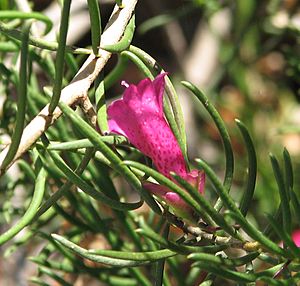Narrow-leaved poverty bush facts for kids
Quick facts for kids Narrow-leaved poverty bush |
|
|---|---|
 |
|
| The narrow-leaved poverty bush growing in the Geelong Botanic Gardens | |
| Scientific classification | |
| Genus: |
Eremophila (plant)
|
| Species: |
alternifolia
|
| Synonyms | |
|
|
The narrow-leaved poverty bush (scientific name: Eremophila alternifolia) is a plant that belongs to the figwort family. This plant is found only in certain parts of Australia. You can find it in the far west of New South Wales, the southern part of the Northern Territory, and the southern half of Western Australia.
This shrub can look quite different from one plant to another. Its size, the shape of its leaves, and the color of its flowers can all vary. Indigenous Australians traditionally used the leaves of this plant to help treat health problems like colds and skin infections. Scientists have also found that the leaves have special compounds that can affect how the heart works.
Contents
What it Looks Like
The narrow-leaved poverty bush is a shrub with many branches. It usually grows to be about 1 to 4 meters (3 to 13 feet) tall. Its branches have many small, raised bumps that contain a sticky substance called resin. They also have marks where old leaves used to be.
The leaves grow in an alternating pattern along the stem. They are typically about 20 to 40 millimeters (0.8 to 1.6 inches) long and 1 to 3 millimeters (0.04 to 0.12 inches) wide. However, their size can vary. The leaves can be almost round like a cylinder, or flatter and egg-shaped. Each leaf has a small point at its tip.
Flowers and Fruit
The flowers of this plant can be many different colors. They might be purple, red, pink, white, cream, or yellow. You can see them on the plant from early winter until early autumn. Each flower grows by itself where a leaf meets the stem. It sits on a curvy stalk that is usually 20 to 40 millimeters (0.8 to 1.6 inches) long.
Each flower has five sepals, which are like small, greenish-yellow or reddish leaves that protect the bud. These sepals are mostly 7 to 10 millimeters (0.28 to 0.39 inches) long. The five petals are 18 to 30 millimeters (0.7 to 1.2 inches) long. They are joined together at their base to form a tube. The top four parts of the flower tube are pointed, and the bottom part spreads out.
The plant flowers from June to October. After the flowers, the plant produces fruit. These fruits are dry, woody, and shaped like a cone. They are smooth and about 5 to 7 millimeters (0.20 to 0.28 inches) long.
Plant Name and History
The narrow-leaved poverty bush was first officially described in 1810. This was done by a botanist named Robert Brown. He published his description in a book called Prodromus Florae Novae Hollandiae.
The plant's scientific name, alternifolia, means "having leaves that alternate on each side of a stem." This describes how the leaves grow on the plant.
This plant has several other common names. Some people call it the round-leaved poverty bush, scented poverty bush, emubush, native honeysuckle, honeysuckle, or narrow-leaved fuchsia bush.
Different Types of Narrow-leaved Poverty Bush
In 1870, another botanist named George Bentham described two slightly different types of this plant. These are called subspecies:
- One type, E. alternifolia var. alternifolia, usually has leaves that are more like cylinders or needles. Its flowers often have spots. This type is found over a wider area, mostly north of the Trans-Australian Railway. It grows in the Northern Territory and New South Wales.
- The other type, E. alternifolia var. latifolia, has wider leaves. Its flowers do not have spots. This type is mostly found south of the Trans-Australian Railway, in Western Australia and South Australia.
Where it Grows
The narrow-leaved poverty bush grows in dry areas of Western Australia, South Australia, the Northern Territory, and the Barrier Ranges in New South Wales. It can be found in many different places, especially where the soil is stony or red.
How it is Protected
In Western Australia, this plant is very common and grows widely. Because of this, the Government of Western Australia's Department of Parks and Wildlife says it is "not threatened." This means it is not currently in danger of disappearing.
How People Use It
Traditional Medicine
Parts of the narrow-leaved poverty bush have been used for a long time as traditional medicine by Indigenous Australians. A small amount of the plant was used to make a preparation for treating colds and sore throats. A special liquid made from the leaves was used to help people sleep. Other parts of the plant were combined and used on the skin to treat problems.
One Indigenous name for the plant is Tarrtjan. This name means "Goldfields," which refers to a region in Western Australia where the plant is found. Scientists have found special compounds in the leaves of this plant. These compounds can help fight bacteria and also make blood vessels wider.
Gardening
This plant is a beautiful shrub that gets covered in many flowers when it's in season. Like other plants in its group, it is sold as a garden plant because it can handle dry weather. Birds also like it.
It is a common plant in gardens, especially in dry climates. However, it can also grow in places with more humidity. Most types of this plant can handle a bit of frost. They need soil that drains well and lots of sunshine to grow best. It is easiest to grow new plants from cuttings.
Gallery
-
Eremophila alternifolia in Kings Park, Perth
-
Eremophila alternifolia in the Australian National Botanic Gardens



